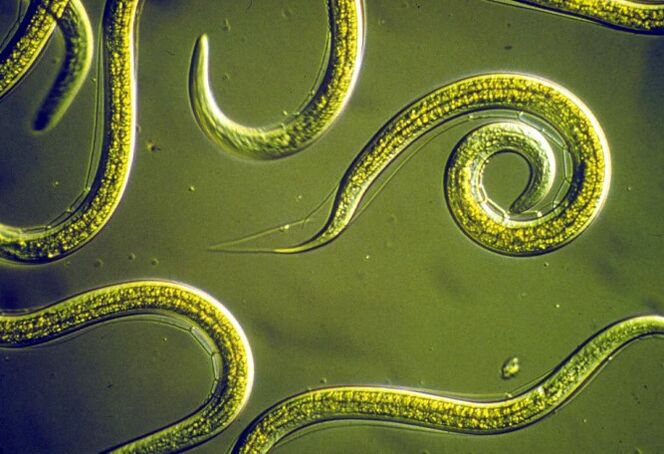Human parasites are parasites, whose infection is subject to a person. The general definition of the word "parasite" applies not only to multicellular and protozoa, living at the expense of its owner and to the detriment of the latter, but also viruses, bacteria and mushrooms with similar qualities. According to the historical tradition, and from the point of view of medical parasitology, it is usual to call any creatures that carry a parasitic lifestyle, except viruses and bacteria with similar qualities.

Parasites include many helminths, fungi, viruses, protozoa, worms, crustaceans, spider -shaped, insects. Parasite owners can be bacteria, simpler, plants, animals and humans. Parasites undergo a complex development cycle: sometimes they need a change of 2-3 owners whose body is intermediate (helminths pass on larval stages) or final (helminths become invasive).
From the story:
The study of parasites in the ancient people is based on the study of feces and other petrified materials. The first parasites found in the man were Paragonimus Westemani eggs of the northern Chile, discovered in hardened feces and dated approximately 5900 BC. and. In Brazil, 5000 BC ancillossis eggs were also found. and. , in Peru - Nematod eggs of 2330 BC. and. And the Egyptian mummies that go back to 2000, 1250 and 1000 years. BC. and. They contained a solitary egg, along with a well -preserved female worm.
In Berlin, for the period of 1866-1875. 16% of all open corpses contained worms of worms. Bull topes (Taeniarhynchus saginatus) was especially widespread where raw cattle was eaten. In St. Petersburg, according to Kessler, 3, 66 % of the people investigated by him suffered from this parasite (1888). Tekenia pork (Taenia Solium) is found everywhere in areas where they eat raw or semi-rude pork. In St. Petersburg, in the late nineteenth century, about 3 % of the population suffered from this parasite. When they began to avoid the use of raw meat, the percentage of diseases decreased extremely, for example, in Denmark of 53 % to 20 % for 10 to 12 years. Dypilidium caninum lives in the gut of dogs and cats, and rarely in the intestines of children. Cases of infection of children in the late nineteenth century were known in England, Germany, Denmark: the infection occurs exclusively when fleas are swallowed.
Parasites and their high(Products of your life) are the strongest poisons for the human body. They cause severe acidification and blood thickening and the entire internal environment. They cause the most serious health disorders. From bronchitis to oncology. Destroy a person's psyche, deprive peace and sleep. In the child's body, parasites prevent normal development of the child's nervous system and, with a long current disease, contribute to mental and physical delay.
Classification
By distribution:

- Ubiqueta - Find everywhere.
- Tropical - Distributed in Tropical Climate Zones.
On biological and epidemiological characteristics:
- Geohelminths is a disease in which helminths first develop in the human body and then in non -viva substrate, more often on earth.
- Biohelminths is a disease in which a biological cycle of helminth development should occur in the body of other living beings except for one person. Distinguish between the end owners, in the body of which the helminths develop for the sexually mature stage, as well as the intermediaries, where the parasite is at the larva stage or their reproduction is not sexually. One person is more often the end owner with less frequency - intermediate.
- Contact helminthiasis is a disease in which parasites are distinguished from the mature or almost mature human body, as a result of which other person's infection is possible or self-reflection (self-invasion, re-invasion).
Depending on the location of the parasite in the body:
- Lighting - Living in the intestine cavity and other cavities of a person (eg ascarides, ribbons).
- Fabric - Living in fabrics (Systems, Ehinokokkoz).
At the place of staying in the owner:
- External: Mosquitoes, blind, leeches, lice.
- Internal(Helminthias):Round worms(Nematodes - ascarids, filaaria, vlasov, pinworms, strungyloids, ancylostomidae, trichinella);Plans:
- Trematons (Pires - Cat Bickelter (Opisthorchis), Clonner, Fasciola, Schistosome);
- Cestodes (Ribbon Worms - Taurus and Pig Meat, dwarf tanning, wide ribbon, echinococcus).
- Bacteriosis(Leptospira, Staphylococcus, Streptococcus, Shigella).
- Protose(Amebas, giardia, trichomonas, usually the owners of the Chlamydia virus and AIDS).
- Mycosis(fungal diseases) - Candida, Cryptococcus, Penicillium.

How do parasites enter the body?
Parasitism can be infected not only through dirty hands. Animal hair is a worm carrier (ascarized and toxocara), Lamblia. Wall eggs that have fallen from wool remain viability for up to 6 months and powder, toys, rugs, underwear and bedding and hands fall into the food dealing. A dog through wet breath disperses the eggs at a distance of 5 meters (cat - up to 3 meters). Dog fleas also tolerate worm eggs. Askarid eggs enter the body through poorly washed vegetables, fruits, fruits, vegetables, dirty hands and are also scattered to flies. And incorrectly boiled barbecue or home -made lard is the path of trichnelosis infection; Poor salted fish, caviar - opistochiasis and broad ribbon.
So there are several ways to enter the body:
- food (through infected foods, water, dirty hands);
- Contact the property (through household items, infected family members, pets);
- Transmissible (through insects that suffocate blood);
- Percutaneous, or active (where the larva penetrates the skin or mucous membranes during contact with infected soil when bathing in open reservoirs).
Parasitic symptoms
It is not necessary for the infection to somehow manifest itself. Sometimes a person feels healthy despite the invasion, thanks to strong immunity. Some individual time it will be healthy. So, therefore, the extinction of immunity (a collapse may occur at any time, stress, surgery, illness) - parasitic silent signs will still begin to serve. This is a smelling urine, acne on the skin, stubborn cough with clean lungs, unstable feces with odor or pungent constipation, gas formation, unpleasant mouth odor. The most specific manifestation of the presence of helminths in the body is bruxism (night rattle of teeth). Night salivation, usual nausea, perversion of night hunger appetite, tireless hunger, sweet and acidic food addiction and air throws. Children have a decrease in appetite or electoral appetite. Sometimes people with greater appetite are found, but at the same time they lose weight.
General signs of parasitic invasions
Constipation, stagnation of bile

Some worms, due to their large shape and sizes, may mechanically close the gut lumen, biliary tract ducts, which leads to deterioration in peristalsis, constipation formation, complete or partial intestinal obstruction. Hlybon invasion can cause the common biliary duct blockage, which leads to difficulty in leaving bile mechanical jaundice.
Diarrhea
Several parasites, especially protozoa, produce prostaglandin -like substances, which lead to sodium and chloride to loss, which in turn causes the aqueous intestinal movements of diarrhea.
Gastric and intestinal discomfort syndrome
Parasites living in the upper gut cause inflammation and lead to the interruption of the intestine, swelling. This leads to a decrease in nutrient absorption. As a result, fats that should be absorbed into the small intestine fall into the colon, causing cramps, alternating constipation and diarrhea.
Pain in the joints and muscles
Parasites can move around the human body to settle in the most convenient places, for example, in joint fluid and muscles. Inflammation of the tissue is the result of harming them with parasites or the body's immune response to their presence. At the same time, a person experiences muscle and joint pain.
Allergy
Parasites may interrupt the normal permeability of the intestinal mucosa, which increases the risk of penetrating large non -digested food particles in them. This activates the body's immune response - the level of eosinophils - protective blood cells of our body, which contribute to the development of allergic reactions, increases. The parasites cause increased production by the body of immunoglobulin and, which increases allergic reactions.
Problematic
Intestinal parasites can cause allergic skin reactions - atopic, hives, eczema dermatitis. Most of the time, inflammatory changes in the skin may be the result of the presence of protozoan microorganisms (Lamblia, mushrooms) and Optuchis.
Body weight change
Weight fluctuations (more than normal and less) may be the result of a parasitic disease. Weight reduction is due to the fact that digestion is impaired in the body as there is an "internal consumer". Obesity is also a consequence of the "theft" of the human body with a helm tentn. The feeling of hunger occurs with a sharp drop in blood sugar due to helminth activity, its toxic effects on the body.
Anemia
Many types of intestinal helminths are attached to the intestinal wall, damage it, causing a sufficiently larger blood loss, which leads to anemia.
Nervousness, sleep disturbance
Toxic substances of parasites' vital activity irritate the central nervous system, causing increased anxiety and nervousness. Frequent awakening in the middle of the night, especially between 2 and 3 hours, is also the result of body attempts to get rid of toxic substances through the liver.
"Chronic fatigue syndrome"
"Chronic fatigue syndrome" includes causal weakness, decrease and fever, emotional instability, loss of concentration and bad memory. These symptoms may be the result of anemia, intoxication, lack of nutrients in the body caused by parasites.
Having discovered their families of various symptoms, suffering diagnoses on parasitism and conducting a pre -trial deworks course.

Diagnosis
Recently, the presence of parasites was determined only by the duodenal sound testing method and feces using microscopic studies, whose objective is to detect selected helminths or their fragments, eggs and larvae. Eggs and parasitic helminth larvae in the liver, bile paths, pancreas and duodenum were found in biliary and duodenal content; Regarding the intestinal forms of Helminths, they examined stool samples; In case of suspected Paragononimoz, the sputum was investigated and urine - urine in genitourinary quokers. But the reliability of these studies depends on employee professionalism - if the laboratory assistant will notice the microscopic parasitic examination. In addition, if the parasite did not postponed the eggs when the check is performed, its presence will be unnoticed, even with high qualifications of the laboratory assistant. Often only 8 to 10 attempts can you get a positive result.
Today there are immunological studies that allow to determine in the blood of a person infected with the presence of antigens and antibodies to parasites of various types. The reliability of such analyzes depends on the life cycle of parasites and their amount in the body.
The most vulnerable to the effects of parasites are children. They are infected with various types of parasites through dirty hands, sand, soil and water. Sometimes the child's infection can occur in intrauterine, since the simplest larvae, bacteria, viruses, candidate and helminth can penetrate the fetus through the placenta with blood flow, as well as during birth through the birth canal.
Do not risk the health of your children, conduct preventive courses of worker.






































